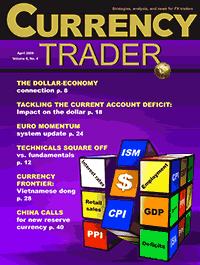WEEKLY OUTLOOK - Week of December 19, 2010
Highlights
US tax cut/stimulus passage strengthens US outlook
EU summit fails to address short term debt concerns
The BOE stuck between a rock and a hard place
Commodities remain firm – Even when faced with USD strength
Key data and events to watch next week
US tax cut/stimulus passage strengthens US outlook
The USD finished the week at its best levels since the Dec. 1 high and may be set for further gains. With the passage of the tax cut extensions and accompanying stimulus measures, political uncertainty over the US outlook has been resolved favorably and markets are increasingly drawn to the buck on better relative growth prospects. US Treasury yields initially popped higher as the compromise was viewed as a deficit disaster, but price action this week suggests US rates may have seen a significant top. A prominent 'shooting star' is evident on the weekly candlestick charts, a bearish reversal pattern after a rally. Falling US yields may provide some headwinds to a higher USD, but we think the effects will mostly be seen in USD/JPY, which now looks firmly capped below 84.50, either declining or not gaining alongside USD strength elsewhere. As well, EUR/USD also posted a prominent weekly 'shooting star' and was rejected from the top of the weekly Ichimoku cloud at 1.3511 and is closing the week below the weekly Kijun line at 1.3217. EUR/USD is already below the daily cloud, suggesting the path lower remains open. While we are mindful of the potential for range conditions to persist as we head into the holidays, a daily close below the 1.3102 200-day mov. avg. suggests to us that recent 1.2980 lows will soon be tested and likely fail, opening up potential lower to the 1.26/27 area next.
EU summit fails to address short term debt concerns
EU leaders adopted language to amend the EU constitution (technically the Lisbon Treaty) to allow for a permanent resolution mechanism in the event of a sovereign default or insolvency after the expiration of the EFSF in mid-2013. But concrete details of how the mechanism would work (esp. over how much private bond investors would be at risk) were noticeably lacking. EU finance ministers are expected to draft those procedures over the coming months. Most importantly, the impasse over the current crisis remains unresolved and continues to undermine confidence in the EUR. The core (Germany and France) remains opposed to increasing the size of the EFSF, leaving markets unsure whether enough funds are in place in case of a credit squeeze on larger EU nations like Spain or Italy. Spanish yields remain near their highs as investors balk at buying more government debt (a Spanish debt auction was undersubscribed this past week), increasing the chances that Spain will be shut out of markets. This leaves the ECB as the buyer of last resort, a role they increasingly don't want to play as it may undermine their hard-earned credibility. Against this backdrop, until there is a sufficient increase in the EFSF or more certainty of aid for Spain, the EUR is likely to remain under pressure.
The BOE stuck between a rock and a hard place
Data out of the UK was relatively mixed this week, but markets chose to focus on the negative. Better than expected retail sales (excluding autos and fuel) at +1.8% YoY seemingly evidenced resilient consumer spending as a source of strength for the British economy. However, the rise in the October ILO Unemployment Rate (3mths) to +7.9% (exp. steady at 7.7%) suggests a moderating labor market recovery. Further muddying the data picture this week was the November UK Nationwide Consumer Confidence Index which fell to 45 from 52, the lowest level in 20 months. The rise in the unemployment rate alongside a substantial drop in consumer confidence points to a bumpy ride ahead for the economic recovery. This is even more apparent considering the rise in retail sales is likely partially due to increased big-ticket spending ahead of the VAT increase in 2011, meaning demand has simply been shifted forward and may subsequently disappoint.
The Bank of England Minutes is set for release in the week ahead and is likely to confirm the MPC is stuck between a rock and a hard place. Inflation has picked up as seen in the November headline CPI uptick to 3.3% alongside expectations for 2011 by half a percent to 3.9%. However, the economic recovery has been ambiguous – the recovery in the industrial sector has made strides but housing and services continues to struggle. We expect the upcoming release of the Minutes to show no immediate policy or voting changes and to conclude that further data watch is necessary for future policy direction.
While the MPC may be on the fence in terms of the future of the UK economy, we believe considerable downside risks to growth may come to a head. Firstly, potential downside impacts of the January VAT hike have been brushed aside as largely insignificant. However, considering accelerating price gains and unemployment rates – the risk is for a larger than expected negative impact to consumer spending. Additional concerns arise from continuing problems facing peripheral Euro-zone economies. About 14% of the UK’s exports go to the peripheral countries (Portugal, Italy, Ireland, and Spain), which implies substantial risks to UK growth prospects. Further UK reliance on the health of a troubled euro-zone periphery can be seen in UK credit conditions. Ireland and Spain account for more than 16% of outstanding loans to UK households and 10% to corporations. An implosion in the Irish and Spanish banking sectors would have a considerable spillover effect to UK credit markets and subsequent negative pressures on growth figures.
Commodities remain firm – Even when faced with USD strength
While for some, to see gold and the dollar appreciate may seem strange, to us it seems increasingly likely. As European sovereign debt concerns continue to mount, gold and silver are likely to remain in high demand as investors look to diversify away from their euro’s (fiat money) in search of tangible currency alternatives. As if we didn’t need further reminding, earlier today Moody’s downgraded Ireland by 5 notches to Baa1 from Aa2 (the outlook remains negative) and this is just days after Moody’s placed Greece and Spain’s ratings on review for possible downgrades earlier in the week. On days where there is significant USD strength (ie: lower EUR/USD), look for commodities to take a bit of a dive initially but then once the currency pair stabilizes, look for commodities to rebound and take flight back higher. If you like to think outside the box, long XAU/EUR could be an attractive strategy to keep your eye on as it potentially profits from both gold strength and euro weakness.
Another commodity on our radar of late is oil. Last week the International Energy Agency noted an upward revision to their 2011 global oil demand forecast of +260,000 bbl/d or +1.6% YoY – which is largely in line with OPEC’s projections for oil demand growth of +1.3%. Additionally, this week’s D.O.E. report of weekly inventories showed U.S. stockpiles declined more than expected, by -9.85 million barrels, which is the largest drop in 8 years. Accordingly, we have revised our outlook for oil prices to the topside over the coming weeks as current market developments indicate considerable tightening in the oil market.
Key data and events to watch in the week ahead
United States: Monday – Nov. Chicago Fed Activity Index Tuesday – ABC Dec. 19 Consumer Confidence Wednesday – MBA Dec. 17, Mortgage Applications 3Q GDP, Personal Consumption, GDP Price Index, & Core PCE, Nov. Existing Home Sales, Oct. House Price Index Thursday – Nov. Durable Goods Orders, Personal Income, Personal Spending, & New Home Sales, Weekly Jobless Claims, Dec. Final U. of Michigan Confidence Survey
Euro-zone: Sunday – German Finance Ministry Nov. Monthly Report Monday – Oct. ECB Euro-zone Current Account, Dec. Advance EZ Consumer Confidence, German Nov. Producer Prices Tuesday – German Jan. GfK Consumer Confidence Survey Wednesday – German Nov. Import Price Index, German IFO Dec. Business Climate Survey, EU Entry Negotiations with Croatia
United Kingdom: Monday – Dec. GfK Consumer Confidence Survey, Tuesday – Nov. Public Finances Wednesday – Bank of England Minutes, 3Q Final GDP & Total Business Investment, 3Q Current Account Thursday – Nov. BBA Loans for House Purchase
Japan: Monday – Oct. Final Coincident & Leading Indexes, Nov. Tokyo & Nationwide Department Store Sales, Nov. Convenience Store Sales Tuesday – Oct. All Industry Activity Index, Nov. BOJ target rate Wednesday – Nov. Trade Balance, BOJ/cabinet office monthly Economic Report, Nov. Supermarket Sales
Canada: Monday – Oct. Wholesale Sales Tuesday – Nov. CPI, October Retail Sales Thursday – Oct. GDP
Australia & New Zealand: Monday – New Zealand Nov. Performance Services Index Tuesday – New Zealand Nov. Net Migration, Australia Oct. Conference Board Leading Indicator, RBA Dec. Minutes, New Zealand Nov. Credit Card Spending Wednesday – New Zealand 3Q Current Account, Australia Oct. Westpac Leading Index Thursday – New Zealand 3Q GDP Friday – New Zealand Money Supply M3















0 comments:
Post a Comment